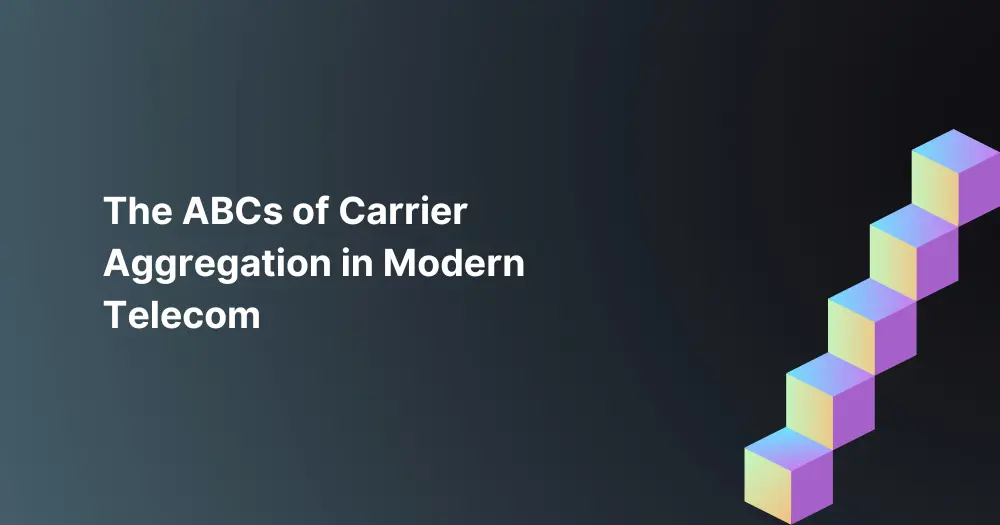
In an era where data is king, and high-speed connectivity is crucial, understanding the underlying technologies that power our networks is essential. One such technology is carrier aggregation.
Carrier aggregation is a method used in wireless communication to increase the data rate and enhance network performance. It achieves this by combining multiple carrier frequencies into a single data channel. This process helps create a wider bandwidth that allows more data to be transmitted simultaneously.
Think of carrier frequencies as individual streams. Each stream can only carry a certain amount of water (or, in this case, data). Now, imagine combining several of these streams into one large river. The result is a significant increase in the volume of water that can flow at any given time. In telecommunications, carrier aggregation combines these streams (carrier frequencies) to form a larger river (data channel), thus increasing data flow.
Carrier aggregation isn’t just a fancy term; it’s the backbone of modern 4G and 5G networks. These advanced networks rely heavily on carrier aggregation to deliver the high-speed connectivity we enjoy today.
In 4G networks, carrier aggregation increases peak data rates, which provide users with faster internet speeds and a smoother browsing experience.
When it comes to 5G networks, carrier aggregation takes on an even more crucial role. It allows for combining frequencies across different spectrum bands, including the low-band, mid-band, and high-band frequencies. This flexibility is key to achieving the incredibly high speeds and low latency that 5G pledges to deliver.
Skyrocketing Data Speeds
Slow data transfer rates can lead to delayed communication, hindered operations, and lost opportunities. This is where carrier aggregation steps in.
Carrier aggregation combines multiple carrier frequencies to create a wider data channel. This process boosts data transfer rates, which allows faster communication and more efficient operations. Whether uploading large files, streaming high-definition video calls, or running real-time analytics, businesses can do it swiftly and smoothly with carrier aggregation. The result? Enhanced productivity, improved customer service, and a competitive edge in the market.
Enhanced Network Performance
Network reliability and coverage are other critical aspects that influence a business’s performance. Intermittent connectivity or dead zones can disrupt operations and negatively impact customer experiences.
Carrier aggregation enhances network performance by utilizing multiple carrier frequencies. This not only ensures consistent connectivity but also expands network coverage. By mitigating network interruptions and downtime, carrier aggregation enables businesses to provide seamless customer services, fostering trust and loyalty.
Scalability
As businesses grow, so do their data needs. Expanding network capacity to accommodate this growth can take time and effort. Carrier aggregation offers an effective solution.
Carrier aggregation allows for network expansion without significant infrastructure changes by combining multiple carrier frequencies. It provides a scalable solution that can adapt to increasing data demands that support business growth and expansion. This means businesses can future-proof operations, ready to take on increased data loads as they expand.
But the benefits of carrier aggregation don’t stop here. It also paves the way for innovative applications like virtual reality (VR), augmented reality (AR), and the Internet of Things (IoT), opening new avenues for business innovation and growth.
Carrier aggregation can significantly impact real-time operations, customer service, and remote work by boosting data speeds and enhancing network performance.
Real-Time Operations: Speed Is Key
In the dynamic business landscape of today, real-time operations are a necessity. Whether video conferencing, leveraging cloud-based services, or conducting real-time analytics, businesses require high-speed data transfer to ensure seamless business operations.
Carrier aggregation provides the high-speed connectivity required for these real-time operations. Faster data speeds mean quicker file transfers, seamless video calls, and instantaneous access to cloud-based resources. This enables businesses to make quick decisions, collaborate effectively, and stay competitive in their respective markets.
Elevating Customer Service with Improved Network Performance
Carrier aggregation enhances network performance by ensuring steady and reliable connectivity. This allows businesses to respond to customer queries swiftly, maintain stable communication channels, and provide uninterrupted service. This enhances customer satisfaction, loyalty, and a positive brand image.
Remote Work: The New Normal
The COVID-19 pandemic has made remote work the new normal for many businesses. This shift has underscored the importance of reliable and fast internet connectivity.
Businesses can ensure high-speed internet access for their remote workforce. Whether it’s attending virtual meetings, accessing cloud-based tools, or collaborating on shared documents, employees can do it all without any hiccups. This ensures business continuity and enhances employee productivity and job satisfaction.